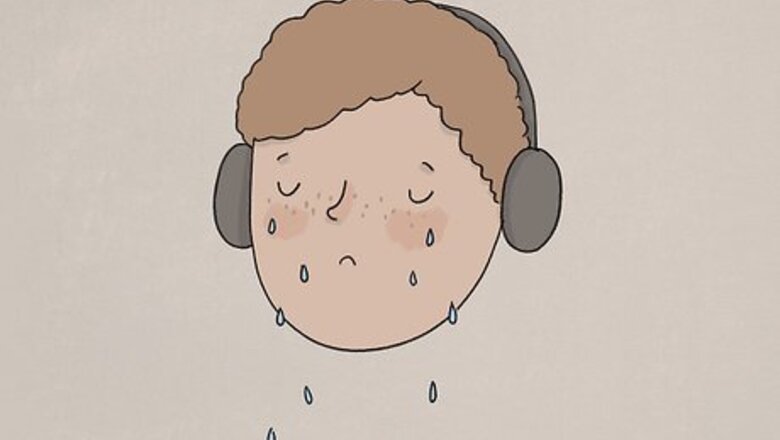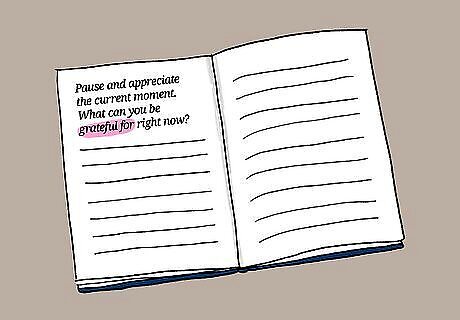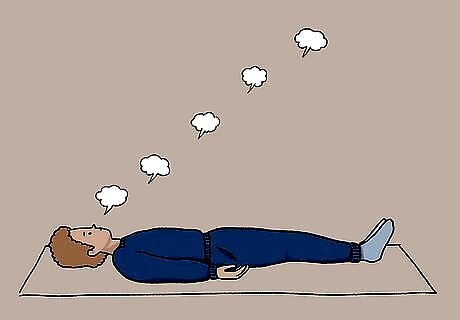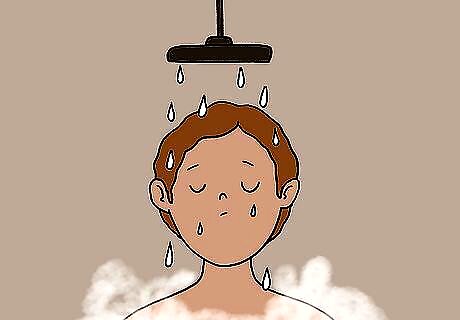
views
Listen to emotional music.

Listening to sad tunes is an effective way to feel heard and understood when you’re going through a tough time. This type of music also puts you in the right headspace to properly address what’s upsetting you, and gives you the freedom and space to cry your heart out. Did You Know? Emotional crying releases feel-good hormones and also helps get rid of stress-related hormones. It’s different from the physical types of tears the body generates in response to eye irritation.
Watch sad movies.

Like sad music, sad movies can put your mind in the proper headspace for crying and getting emotional. For a more potent and cathartic cry, try tapping into your own emotions and experiences while watching a tear-jerking movie. Your crying session may leave you feeling more refreshed and rejuvenated if you connect your feelings about the movie with your real-life experiences.
Read something emotional.

Like music and film, books can play with our emotions in profound, heartbreaking ways. Reading a notoriously sad, punch-in-the-gut book can help put you in the proper headspace for a good cry—especially if the book covers themes similar to your own grief and sadness. For example, reading Marley and Me by John Grogan can hit hard if you’re coping with the loss of a pet, while My Sister’s Keeper by Jodi Picoult might pull at your heartstrings if you’re struggling with a cancer diagnosis in your family.
Look at old pictures.

This is a surefire way to get the tears flowing if you're sad about a particular person, or if you’re feeling nostalgic about how much life has changed. Go through an old photo album or pull up pictures online and allow yourself to gaze at each one for as long as you want. Remember the good times you had with the people in the pictures, or how much you loved a particular place. Looking at old texts and social media posts can also be a way to stir up emotions about a deceased loved one or a place you aren’t able to visit anymore.
Relive sad moments or scenarios.

Try to envision exactly how you felt in the past when something sad happened, like a breakup or pet death. If you’re having trouble invoking a sad moment from your own life, try inventing a sad scenario for yourself, like how you would feel if your loved ones were no longer around. Really try to capture this headspace—if you feel emotional enough, the tears might start falling.
Write down your feelings.

Journaling allows you to express and organize your thoughts in an open, non-judgmental environment. Focus on writing whatever feels best to you—you might jot down what’s weighing on your mind, or express something traumatic that happened recently. As you write, you might find those strong emotions welling up to the surface, allowing you to cry. Try to set aside intentional time for journaling each day, even if it’s only for a couple of minutes at a time.
Practice gratitude.

Thinking about what you’re thankful for can help you feel especially emotional. Let’s say you have a sibling who survived a severe car accident, or a relative who beat a difficult medical diagnosis—thinking about what they went through and appreciating how they’re still with you could lead to an emotional, tear-filled moment. Having a gratitude journal can be a helpful way to nurture thankfulness in your daily life. It can be a notebook or just a note on your phone that you periodically use to acknowledge the good things in your life that you’re thankful for.
Try doing some holotropic breathwork.

Lie down on a flat surface and take a series of deep, quick breaths, one after the other. Repeat this breathing pattern for a couple of minutes or even longer, if you’re feeling up to it. While it’s officially recommended to do this breathwork in a supervised setting, see if a friend or loved one can supervise you if you’d rather try out holotropic breathwork at home. This style of breathing can help you release difficult emotions, and it’s sometimes used to treat conditions like anxiety, substance abuse disorder, PTSD, and more.
Stare at something without blinking.

Look at something in the distance, like your ceiling, computer screen, or door. Force your eyes open for an extended period of time (at least 20 seconds) until tears start to build up. Then, see if you can connect that teary sensation to a recent emotional experience, so you can enjoy a more cathartic, emotional cry. For instance, you might think about a recent break-up after staring at the wall for 30 seconds. With your eyes already teary, it might be easier to start crying as you think about how upset you are. Keep in mind that the act of staring without blinking won’t yield an emotional cry. You’ll have to do some extra legwork to yield all the benefits of a good cry.
Yawn multiple times.

The motion of yawning can impact your tear glands and make your tears flow naturally. To trigger this sensation, try forcing yourself to yawn several times in a row (or actually yawn if you’re feeling sleepy enough). Once your eyes start to water and tear up, focus on a sad or upsetting event to help get some emotional tears flowing. Yawning multiple times won’t create the emotional cry you’re looking for. It may help to do other sad activities (like listening to sad music) to help those tears flow.
Chop up some onions.

When onions are chopped up, they release a substance known as syn-Propanethial-S-oxide. As you cut, the substance gets into your eyes, irritates them, and causes tears to form. While you’re chopping onions, focus on a sad memory or event to help your onion tears transition into real tears.
Do an intense workout.

It’s a well-established fact that exercise helps boost the feel-good chemicals in your brain and makes you feel better overall. But what about its tear-jerking capabilities? Some people find that doing really physical workouts (like kickboxing) can be a great outlet for negative emotions, and might make it easier to cry about a tough situation. After having a tough fight with a close friend, you might punch a punching bag for a cathartic workout. As you punch and release those negative feelings, you might find it easier to cry. Not in the mood for something intense? Try doing some yoga instead! Certain yoga poses, like ones that target the hips (e.g., the pigeon pose) might make it easier to cry.
Head outside on a walk.

Being able to cry and let it all out really depends on the headspace that you’re currently in. Going outside and taking a quick stroll around the block (or at your local park) can make it easier for you to really focus on your thoughts and feelings rather than being distracted by the hustle and bustle of daily life. Walking has plenty of other benefits, too! It helps produce feel-good chemicals in your brain, and may even help with long-term health struggles like memory difficulties and dementia. Think deeply about what's making you sad. Instead of letting your thoughts skip away to something less important, focus your mind on the emotions swirling around in your head. Just let yourself think through them instead of trying to push them away.
Hop in the shower.

Everyone needs a safe space where they can cry and let it all out. Many people find the shower to be an ideal spot to let out their emotions—it’s private, and the sound of the water can help muffle the sounds of your crying (if you’re concerned about someone overhearing you). Some other great spots to cry could include your bedroom, your car, or any other place where you can be alone with your feelings. Make sure that you’re in a spot where you feel truly safe and comfortable. Crying in your bedroom, for example, might feel more cathartic than crying in a public bathroom.
Confide in someone about your feelings.

Verbalizing your feelings might help get some of the tears to flow. Venting to a friend or loved one about a tough struggle can be a cathartic experience, and provides a vulnerable and safe space for you to feel your feelings. Reach out to someone you trust and see if they’d be comfortable lending a listening ear. It might be helpful to see a therapist if you think certain emotional struggles or difficulties are preventing you from crying and getting the release you desire. A therapist can help you work through your past and examine your emotional challenges in an honest but non-judgmental way.
Apply a tear stick beneath your eyes.

Tear sticks are sometimes used by actors to help the tears flow in more emotional scenes. They’re also good for real-life scenarios—especially when you struggle to cry on your own terms. Simply apply a little bit of the product beneath your eyes and wait less than a minute for the tears to begin. The more you use tear sticks, the more resistance you’ll build to them. Take it slow and use the stick sparingly.


















Comments
0 comment